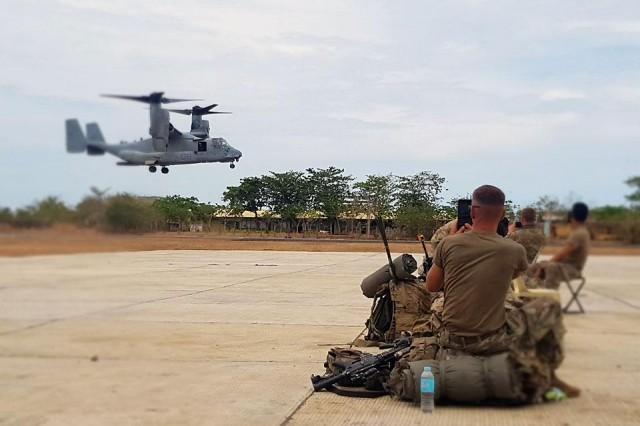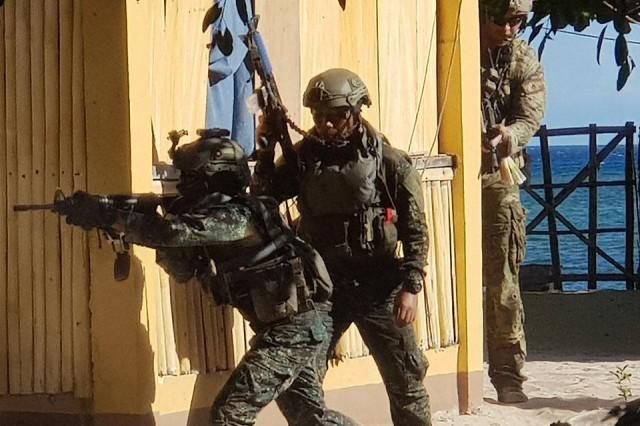
Under the heat of the blinding tropical sun, the Filipino and US troops advanced toward the terminal building manned by the "enemy" — a foreign force that had seized the airstrip located on a small island inside Philippine territory.
Reconnaissance teams hidden in the bush had sent back pictures and data detailing the enemy strength and the number of civilian hostages.
This was one of the last major exercises in Balikatan 2019, held in little known Lubang Island in Occidental Mindoro. Far away from the traditional Balikatan training grounds in Zambales and Tarlac, the airfield seizure exercise not only tested the skills but may have also revealed the current concerns of the Armed Forces of the Philippines.
Gunshots rang out as the OPFOR or "opposing force" started shooting at the approaching soldiers. Amid the gunfire, the "hostages" inside the building were herded out by their captors.
Enemy defenders maneuvered and resisted the advance, flanking the assault teams and even staging an ambush from the rear.
The guns used in the combat training exercise were real; the ammunition, however, were called milsims, a special training cartridge that shot a chalk pellet and left a mark when it hit the target. "Dead" soldiers lay on the ground where they were hit and the wounded ones were either evacuated or tied up.
The culmination of years of interoperability training, the byword and justification of almost all 35 iterations of the Balikatan Exercises, was on full display here. However, the shortcomings and challenges were also evident.
"Go! Move! Move! Pak pak pak pak pak," one Filipino soldier shouted, conserving his milsims and trying to simulate the sound of gunfire as his teammates advanced on their enemies.

Elsewhere, an American directing part of the assault was trying to communicate with his Filipino teammate lying prone behind cover.
"Hey, do you have a radio?" the American finally shouted amid the staccato of gunfire.
"No!" the Filipino shouted back.
A burst of automatic gunfire from the rear revealed the enemy was attacking the Filipinos and Americans from behind.
"If you see them, shoot them," screamed someone amid the chaos.
It took the Filipinos and Americans less than 30 minutes to neutralize the enemy, rescue the hostages, and seize the airfield.
US and Filipino soldiers had planned from the mock operations center in Subic Bay. Satellite imagery and operational maps ware plastered on a backboard where the operation was being directed.
"So basically for this scenario in Balikatan 19, foreign military has invaded the Republic of the Philippines. They requested for US support in regaining Filipino sovereignty specifically at the request of AFP SOCOM (Special Operations Command). An airfield in a small island that has been taken over by a foreign military," explains Maj Chris Bolz, the US commander for the airfield seizure scenario.
AFP personnel involved in the exercise confirm that the Philippine military specifically requested this scenario despite it not being part of the original schedule of the exercises for 2019.
"We requested this training dahil based on our assessment ito yung isang bagay na kailangan pa natin na i-increase yung ating capability ng ating armed forces." says Lieutenant Colonel Jonathan Pondanera, one of the senior officers involved in the training.
Pag-asa Island in the West Philippine Sea is one of a few islands in the Philippines with an airstrip.
The AFP has confirmed that Chinese fishing boats controlled by the Chinese Navy have been surrounding Pag-asa in an attempt to establish their presence.
China claims Pag-asa Island as well as the entire South China Sea.
However, Pondanera clarifies that this scenario and preparations in Lubang Island were in no way directed against any specific country.
Professor Jay Batongbacal, an expert on the West Philippine Sea, believes any training is helpful especially if it involves scenarios involving the maritime domain.
"Any exercise that enhances the warfighting capabilities of the AFP in maritime and archipelagic setting is very helpful." Batongbacal said
Security expert Professor Rommel Banlaoi is convinced this type of training is meant to prepare both the US and Filipino soldiers of the possibility of having to join forces to respond to this particular type of attack or invasion.
"That is the purpose of the exercise... to prepare both countries to respond to scenarios requiring joint military actions," he said.
https://www.gmanetwork.com/news/news/nation/691036/phl-us-soldiers-train-vs-foreign-invasion-against-backdrop-of-chinese-presence-near-pag-asa/story/

No comments:
Post a Comment
Note: Only a member of this blog may post a comment.